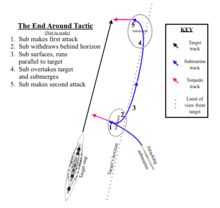End Around (submarine tactic)
The end around was a World War II submarine tactic[1] used when the position of a submarine (relative to a potential target) did not allow the submarine to mount an immediate attack. The submarine's crew estimated the enemy's bearing, heading, and speed, remaining submerged until out of the enemy's visual range. The submarine then surfaced and proceeded at maximum speed to a position in front of the target, near the target's predicted course but remaining out of view. The submarine would then submerge, approach, and attack.
The WWII submarine attack problem
The location from which a submarine could attack varied mostly according to the relative top speeds of the attacker and its target. Diesel-electric-powered submarines in the Second World War were typically capable of 18-23 knots on the surface under diesel power and up to 9 knots underwater,[2][3][4] where they were restricted (if lacking a snorkel) to battery power. Battle fleets in World War II might have a top speed of up to 30 knots, making it difficult for submarines to achieve attack position. A convoy of freighters or tankers typically proceeded at up to 10 knots.[5] Submarines, especially when submerged, were consequently sometimes slower than their prey. Attack opportunities would also be lost if the target detected the submarine and altered course to avoid attack.
Execution
To attack, a sub usually had to get ahead of its target: the end around was one solution to this problem. If a submarine couldn't attack due to unfavorable positioning, its crew determined the target's course and speed, then calculated a potential torpedo firing point. The end around might then proceed as follows.

- The submarine attempts an initial attack. If spotted by the target or escorts, the sub then usually submerges.
- The submarine moves away from the target (to get out of visual range), then surfaces.
- The submarine proceeds at best speed to overtake and pass the target on a parallel course, using the curvature of the Earth, darkness, and weather events (such as rain, snow, and fog) to stay out of the target's view.
- After gaining position ahead of the target, the submarine approaches, readies torpedoes and calculates an optimal attack.
- The submarine executes the next attack, either while surfaced or submerged.
The process can be repeated as long as the sub is able to do so.
The end around tactic was useful largely because of submarines' low freeboard, which made them less visible than much-taller merchantmen and warships. Using the targets' upperworks and exhaust smoke to estimate and maintain proper distance, a skilled sub commander could maintain a close watch on enemy ships while keeping his own vessel unseen.
Other considerations
A modification to this tactic incorporated the night surface attack, where the submarine remained surfaced. This variation allowed the submarine to take advantage of its higher surface speed during the actual attack, but increased the likelihood of pre-attack detection, which in turn could result in a counterattack by opposing escorts and the targets turning, thus spoiling the attack. Surface attacks could be executed in daylight or to facilitate an attack using the sub's deck gun, again with added risk.
As a defense, ships in wartime can adopt zig-zag sailing patterns rather than practicing more-efficient great-circle navigation. Sailing in zig-zags made computing a target angle more difficult for the submarine crew, especially if the pattern was irregular. Instead of repetitively varying a 90° base course ten degrees either way (80°, 100°, 80°, 100°), a good commander practices irregular course changes: first 80°, then 110°, 95°, 75°, etc. Irregular zig-zagging obscures the target's base course, making interception harder to calculate and complicating the target solution. On the negative side, zig-zags slow a ship's progress to its destination, allowing the sub to overtake more quickly.
References
- Mooney, James L. (23 June 1976). Dictionary of American Naval Fighting Ships, V. 6: R Through S, Appendices, Submarine Chasers, Eagle-Class Patrol Craft. Department of Defense (DOD)Department of the NavyNaval History & Heritage Command. p. 623. ISBN 0-16-002030-1.
- Gato-class submarine
- Type VII submarine
- Japanese submarine I-51
- World War 2: Convoy was the key to defeat of U-boats last time (a 2009 reprint of a 1939 article)